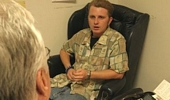Just like you may have Video on Demand as part of your cable or satellite TV service, your brain's got something called Vision on Demand.
What happens when you go to the movies? You enter the theatre and take a seat. It's dark so you'll look at the screen rather than your surroundings. You've got to turn off your cell phone so you don't ruin the sense of suspended reality for the other moviegoers. You sit, watching.
If it's a compelling movie, you feel completely drawn in. You jump when it's startling, you laugh and cry when the story calls for it, you're pretty much at the mercy of the people who made this movie. Your emotions follow suit.
You are so into it that it almost feels jarring when you return back to reality. A great film impacts you so that you still feel it after it's over, and your mind is drawn back again and again.
You roll the plot subtleties over in your mind, wonder what the characters were thinking, replay the soundtrack until it's tattooed on your brain, and feel like you could easily run the dialogue lines with your friends.
Vision on Demand works the same way. You can use this creative visualization technology to harness the engine of your imagination to gain a clearer picture of your success.
By visualizing your peak performance, your achievement, you imprint the details on your mind. Create an image in your mind of your goal. Be as detailed as you can be, including all your sensory factors, until it's as real to you as if you were actually living it.
Our client Kate's goal is to one day live on Sanibel Island in Florida. She's visited there many, many times, and knows the place like she knows her hometown.
When she utilizes her Vision on Demand technology, she closes her eyes and imagines herself driving across the causeway in her convertible. She crosses the bridge, enjoying the view of Ft. Myers to the left, and little islands to the right.
Brown pelicans glide by, as if racing with her car. She comes to the stop sign at the end of the bridge and turns right. Making another quick right, she coasts down a street lined with live oak trees. There's a wonderful canopy overhead, and dappled sunshine on the road.
She turns left just before the waterfront, and sees her home at the end of the road. It backs onto the Gulf of Mexico, which is pale green in the sunlight today.
There are date palms and Washington palms lining the driveway. A white wrought-iron gate swings open, and her car rolls into the driveway.
She hears a solid "thump" when she closes her car door. She can feel the cool metal of her key as she unlocks her door, the rush of cool air-conditioned air as she steps into the foyer. She sees a large pedestal table. On it is a gigantic, exotic fresh flower arrangement, and a note from her husband. "Be back for dinner, I'll bring fresh grouper and a bottle of wine."
She changes into her bathing suit and slips into the refreshingly cool plunge pool on her lanai. Ahhhhh, she relaxes while watching some dolphins swim up the coastline.
Sounds pretty fabulous, doesn't it?
Are you thinking that the fantasy sounds good, but the idea of anything productive coming from spending time with creative visualization is just plain silly? Think about this. What happens when you worry? You focus on a problem you've got. Your mind plays out all bad outcomes possible.
You'll be humiliated. You'll be shown to be a fraud, incompetent. You'll suffer bad consequences. Others will look down on you. On and on it goes. Right when your stomach starts to knot and churn, you push the eject button.
Essentially, there's not much difference in the process between the Florida fantasy and the headache-inducing dread. It's a process like rehearsing. You've conjured up a synthetic experience, it hasn't actually happened, but you can feel it all the same. You can imagine it happening. You're even motivated to take action based on your visualization.
In the worry model, you've played out every detail, the feelings, what you'll see and hear, how you'll act, what everyone will say, it's all unpleasant. In the fantasy model, you've played out the same details, but it's desirable enough that you want to make it happen.
As you go about deciding what you want for your life, spend time using the Vision on Demand technology for every area. The more you practice using it, the easier and more automatic it becomes. You begin to fill in more details each time, and see it more clearly. In doing this visualization, you imprint your wishes on your sub-conscious, which has no choice but to make it so.
Using your Vision on Demand technology will also help you when you run into obstacles on the way to achieving your dream. Whether or not obstacles stop you dead in your tracks depends on how committed you are to start with.
If you've only got some vague idea about someday maybe living a better life, making more money, or getting into good shape, you'll be easily distracted. Our attention span is brief when we're not fully vested in our goal.
Having a detailed image in place is really helpful because it keeps us focused on and actively creating the result we decided to create. It completely revolutionizes our concept of failure. It makes us brave enough to try something we or others haven't done before, or something we've tried before without success.
Winners in life are not people who've never failed. They are people who've probably failed more than other people have ever even tried new things. What separates winners from the rest is that they've learned how to move past failure, keeping their goals in sight all along the way. It takes courage. It takes commitment. It takes a clear and detailed dream and a plan.
If you regularly spend time utilizing the Vision on Demand technology, you are consistently imprinting your goal onto your subconscious mind. When you choose to spend time thinking about what you want, in great detail, you stay motivated. Imagining your success as if it had already happened starts a process by which your mind works to make it happen.
Then, if you have setbacks along the way, they're perceived as small annoyances rather than insurmountable obstacles. In fact, your mind doesn't even recognize them as setbacks at all anymore. They're merely signals to adjust your course so that you're aimed more directly at success.



